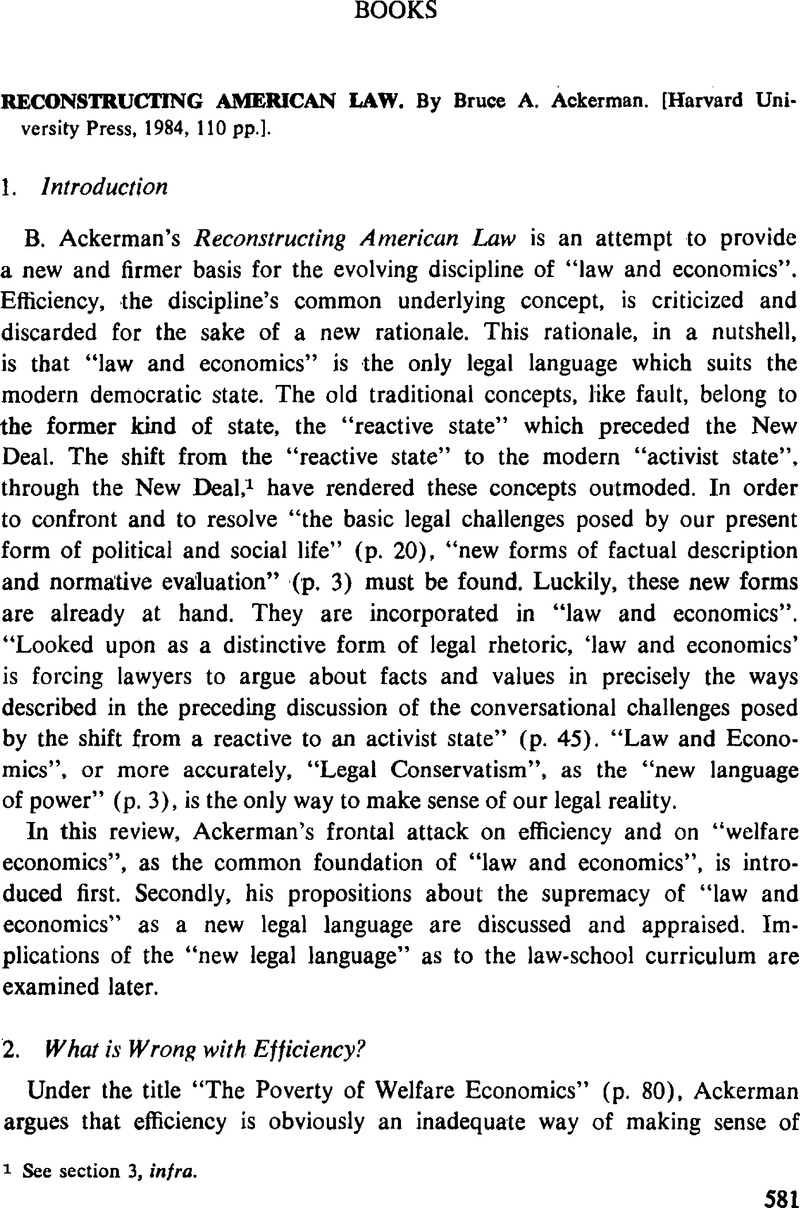No CrossRef data available.
Published online by Cambridge University Press: 16 February 2016

1 See section 3, infra.
2 See Bentham, J., An Introduction to the Principles of Morals and Legislation (1813 ed.), Chap. 1Google Scholar; Copelston, F., History of Philosophy (London, 1963) Vol. VIII, p. 1Google Scholar; Friedmann, W., Legal Theory (London, 5th ed., 1967) 312–321Google Scholar; Harris, J.W., Legal Philosophies (London, 1980) 7.Google Scholar
3 See Stilger, G.J., “The Development of Utility Theory (1950)” in Essays in the History of Economics (Chicago, 1960) 60.Google Scholar
4 Supra n. 2. See also Hart, H.L.A., “Between Utility and Rights” (1974) 79 Colum. L.R. 828.CrossRefGoogle Scholar
5 Tarascio, U.J., “Pareto: A View of the Present Through the Past” (1976) 84 J. Political Econ. 109.CrossRefGoogle Scholar See also supra n. 3.
6 Scitovski, T., “The State of Welfare Economics” (1951) 42 Am. Econ. R. 303, 304Google Scholar; Robbins, L., A Essay on the Nature and Significance of Economics Science (London, 2nd ed., 1952) 152.Google Scholar
7 Chipman, J.S. & Moore, J.C., “The New Welfare Economics” (1978) 19 Int'l Econ. R. 547, 548.CrossRefGoogle Scholar
8 Scitovski, supra n. 6 at 304–8.
9 Kaldor, N., “Welfare Proposition for Economics and Inter-personal Comparisons of Utility” (1939) 49 Econ. J. 549CrossRefGoogle Scholar; Hicks, J.R., “The Foundation of Welfare Economics” (1939) 49 Econ. J. 696.CrossRefGoogle Scholar
10 Posner, R.A., “Utilitarianism, Economics and Legal Theory” (1979) 8 J. Legal Studies 103CrossRefGoogle Scholar, and the two symposia on this subject: one in (1980) 9 J. Legal Studies and the other in (1980) 9 Hofstra L. R.
11 Musgrave, R.A., “Cost-Benefit Analysis and the Theory of Public Finance” in Layard, R. (ed.), Cost-Benefit Analysis (Harmondsworth, 1972) 101 at 103Google Scholar; Scitovski, supra n. 6 at 307.
12 Ibid., at 112–13; Kaldor, supra n. 9 at 550–1.
13 See Calabresi, G., The Costs of Accidents (New Haven, 1970) at 24, n. 1.Google Scholar
14 Bergson, A. (Bruk), “A Reformulation of Certain Aspects of Welfare Economics” (1938) 52 Q.I. Econ. 310CrossRefGoogle Scholar; Scitovski, supra n. 6 at 312.
15 See supra n. 10.
16 See text above, at nn. 11–14.
17 Posner, R.A., Economic Analysis of Law (Boston, 2nd ed., 1977) at 17Google Scholar; Posner, supra n. 10, at 109–110.
18 See, for example, Calabresi, G., “First Party, Third Party and Product Liability Systems: Can Economic Analysis of Law Tell us Anything About Them?” (1984) 69 Iowa L. R. 833.Google Scholar
19 Another commentator, Priest, goes to extremes: It is difficult “…to justify why law is a subject worthy of study at all”; “those with true intellectual courage would abandon the law”; “…faculties of modern law schools resemble faculties of medieval universities”. Priest, , “Social Science Theory and Legal. Education: The Law. School as University” (1983) 33 J. of Legal Education 437, 438–440.Google Scholar
20 Priest, supra n. 19 at 440–1, prefers a structural change. Since law, in his view, is. not a theory in itself, but only the subject of other disciplines, it follows that law school should be comprised of miniature graduate departments in the various disciplines.
21 Sec Calabresi, supra n. 18.